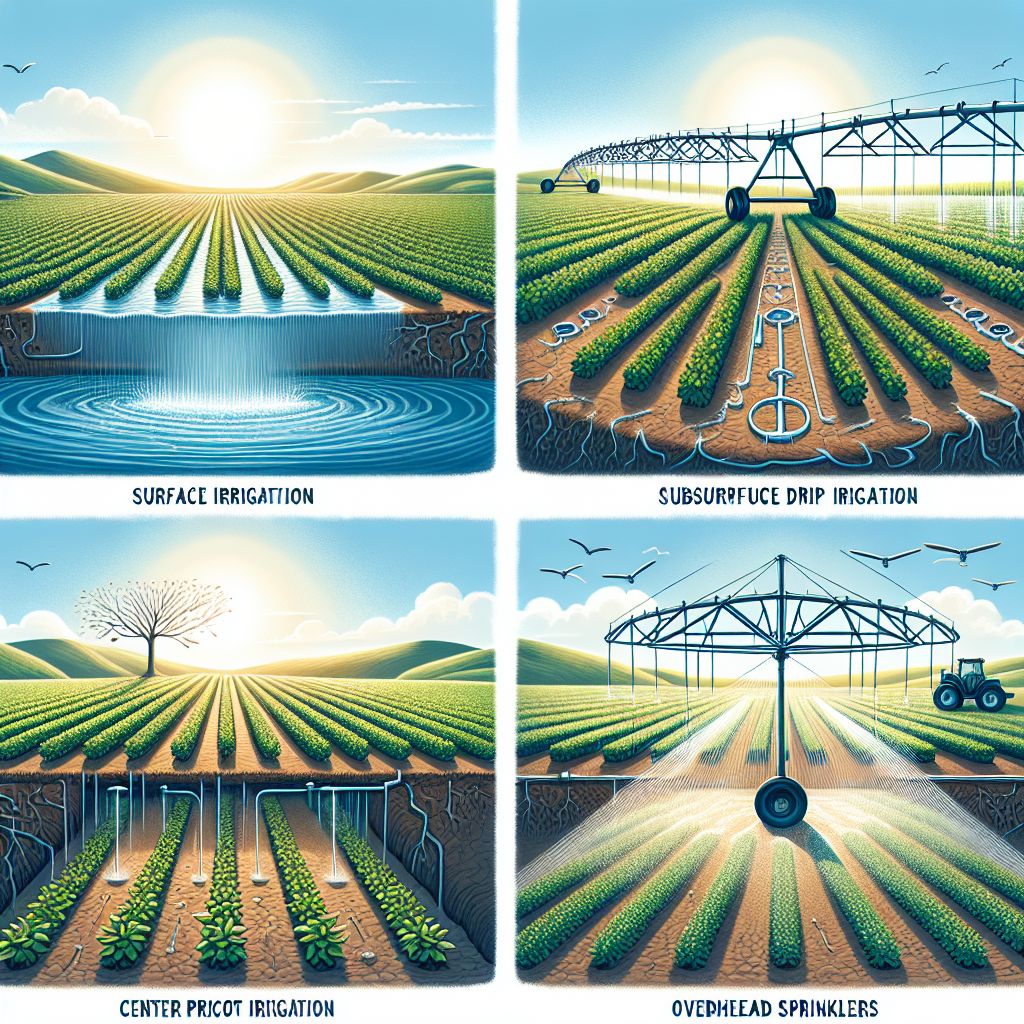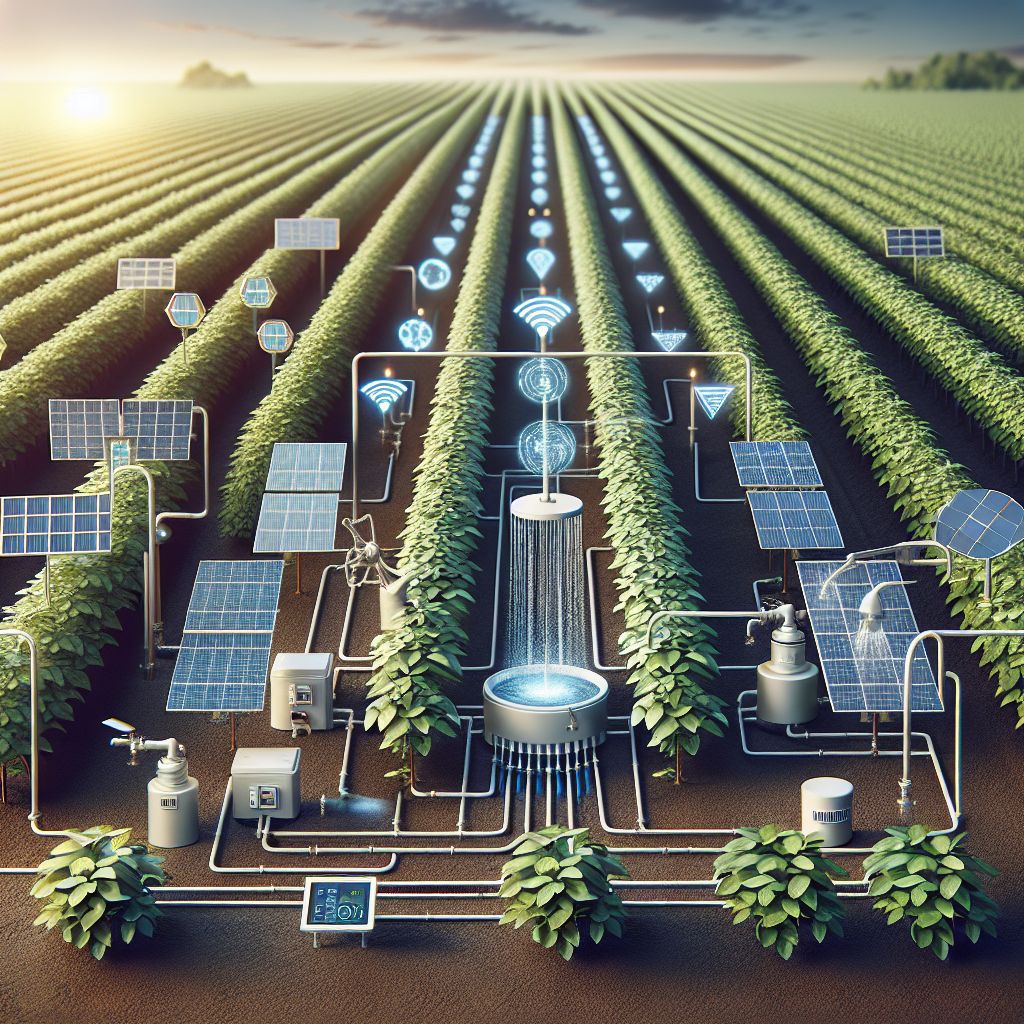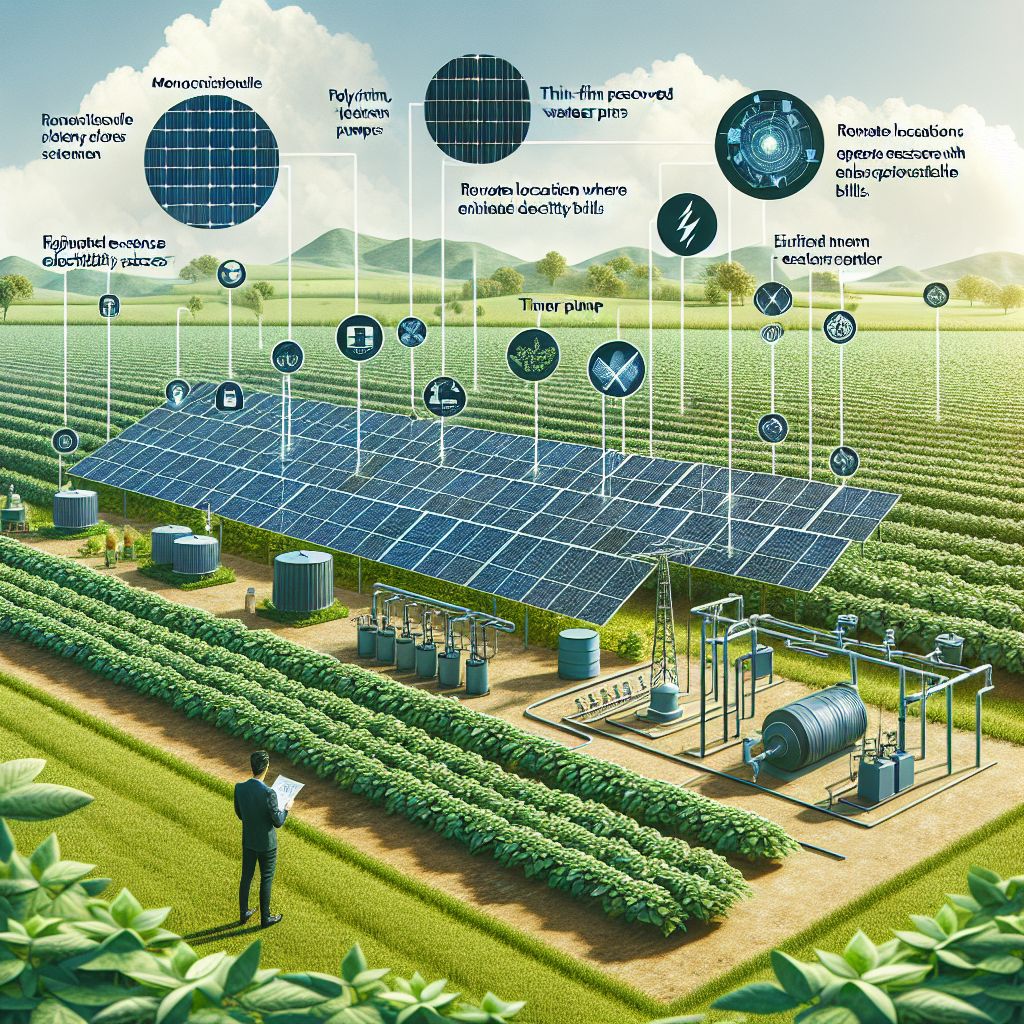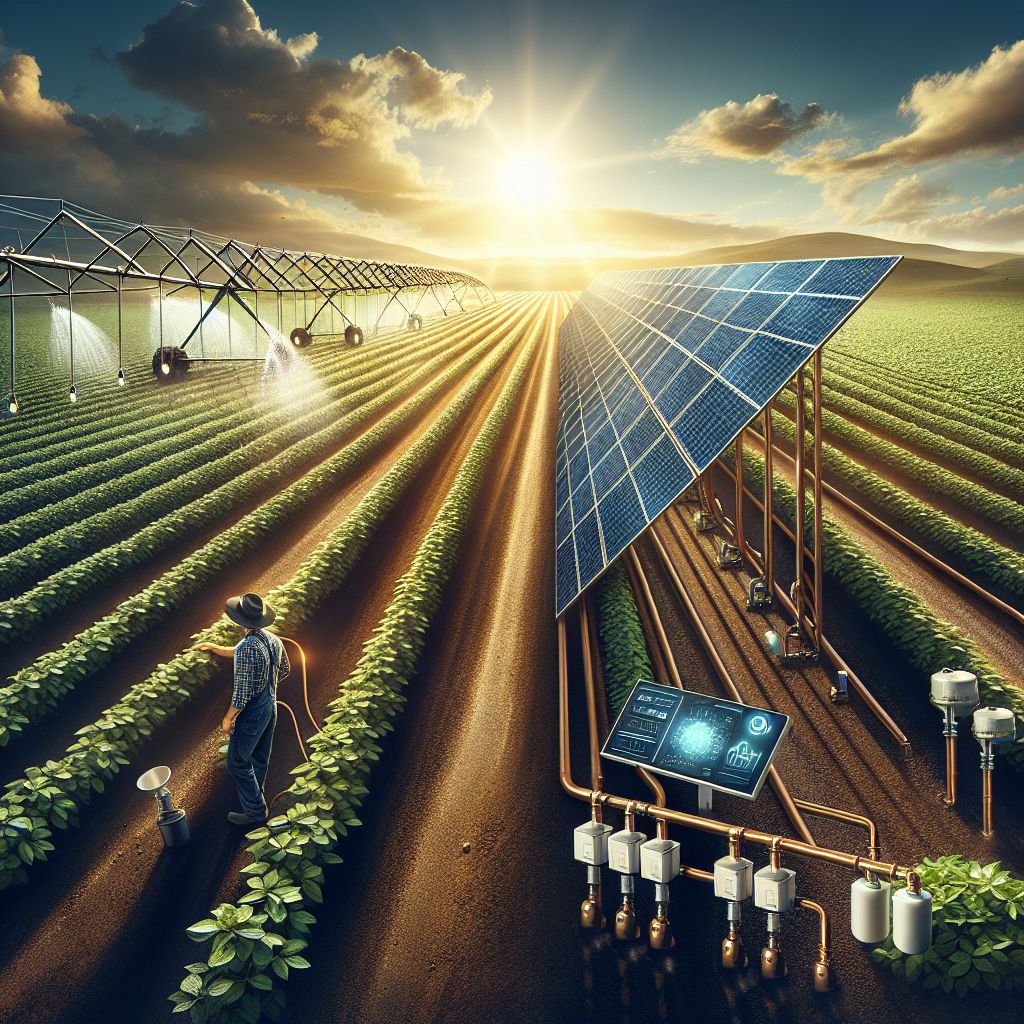
Key Points to Remember
Solar irrigation is a cost-saving and environmentally friendly watering method for soybean farming.
Knowing how much water soybeans need is key to their growth and productivity.
There are various irrigation systems, each with its own advantages and disadvantages.
Solar-powered irrigation can greatly cut down on operating expenses and carbon emissions.
Real-life examples demonstrate how well solar irrigation works in different weather conditions.
The Importance of Water in Growing Soybeans
When it comes to growing soybeans, water is just as important as sunlight. These plants need the right amount of water at the right time to thrive. But it’s not just about keeping the plants from drying out; how you water them can affect everything from the size of the beans to how many you get. That’s why irrigation is so important.
Comprehending the Water Needs of Soybeans
Soybeans are not particularly demanding, but they do have an ideal water range. If they receive too little, their growth will be stunted. If they receive too much, you risk washing away the nutrients from the roots. It’s all about equilibrium. Soybeans require the most water during their essential growth stages, such as pod development and blooming. This is the time to ensure your irrigation skills are up to par.
How to Detect Overwatering and Underwatering
So, how do you know if your soybeans are parched or waterlogged? Check the leaves. If they’re yellowing or wilting, they need water. If they’re falling off or the ground around the plant is waterlogged, you might be giving them too much. Keep an eye on these symptoms to ensure your soybeans are content.

Types of Irrigation Systems for Soybeans
There are several methods to water a soybean field. Let’s explore the different irrigation systems you can use.
Surface Irrigation: The Good and The Bad
Imagine giving your field a shallow bath, that’s what surface irrigation is like. It’s straightforward and doesn’t require a lot of technology. However, it’s not always uniform, and a significant amount of water can be wasted through runoff or evaporation.
How Subsurface Drip Irrigation Works
Think of subsurface drip irrigation as a stealthy water courier for your crops. It’s all about accuracy, delivering water directly to the roots while conserving water and controlling weed growth. However, it can be expensive to install and requires consistent maintenance to ensure it functions properly.
Is Center Pivot Irrigation a Good Fit for Soybean Farming?
Picture a massive, mobile sprinkler that moves across your field like a Ferris wheel. This is center pivot irrigation. It’s ideal for large fields and can be quite efficient in terms of water use. However, it’s not inexpensive, and it may not be the best choice for a field with an irregular shape.
Overhead Sprinkler Systems: Striking a Balance Between Coverage and Conservation
Overhead sprinklers are the old standbys. They are capable of covering a large area and are quite adaptable. However, wind and evaporation can take away some of that water before it even reaches the ground, so it’s crucial to use them judiciously.

Boosting Irrigation System Efficiency with Solar Power
Now, let’s discuss the idea of using sunlight to power these systems. Solar panels can enhance the efficiency and sustainability of irrigation systems. They can operate pumps and timers, allowing you to irrigate your crops without depending on the grid. This can result in cost savings over time and a smaller carbon footprint.
Different Types of Solar Panels
Solar panels are not a one-size-fits-all solution. You can choose from monocrystalline, polycrystalline, and thin-film panels. Monocrystalline panels offer high efficiency and a sleek design, but they are more expensive. Polycrystalline panels are a more budget-friendly option, but they are not as efficient. Thin-film panels are flexible and light, but they require more space to generate the same amount of power as the other types.
Here is a table showing the different solar panels that can be used with an irrigation system:
|
Panel Type |
Pros |
Cons |
|---|---|---|
|
Monocrystalline | – Highest efficiency in converting sunlight to electricity (around 20%). 1, 2 | |
|
Polycrystalline |
– More affordable than monocrystalline. 1, 2 |
– Lower efficiency and shorter lifespan than monocrystalline. 1, 2 |
|
Thin-Film |
– Lightweight and flexible for unique installations. 1, 2 |
– Lowest efficiency (around 7-13%). 1, 2 |
The monocrystalline panels offer the highest efficiency and longest lifespan, making them ideal for residential rooftop installations where space is limited. Polycrystalline panels provide a good balance of efficiency and cost. Thin-film panels have the lowest efficiency but are very lightweight, flexible, and inexpensive, suiting them for portable or integrated applications. 1, 2, 3
The Synergy between Solar Energy and Irrigation
For soybean farmers, the marriage of solar energy and irrigation systems is a revolutionary development. By capturing sunlight, solar panels can power irrigation systems, making farming practices more sustainable and environmentally-friendly. This pairing not only cuts down on dependence on non-renewable energy sources, but it also ensures that crops like soybeans receive the necessary amount of water without contributing to carbon emissions.
First and foremost, solar irrigation systems are equipped with intelligent technologies. They can be programmed to water at the most effective times of the day, minimizing water evaporation and ensuring that plants are watered when they are most capable of absorbing it. This level of accuracy results in healthier crops and potentially a more plentiful harvest.
Additionally, solar irrigation systems are particularly helpful in remote areas where access to electricity is limited. With solar panels, farmers can water their soybean crops without the need for expensive infrastructure or the continuous costs associated with fuel-powered generators. This makes solar irrigation systems not only environmentally friendly but also very practical and cost-effective.
Power irrigation systems with solar panels to lessen reliance on the grid.
Use smart technology to automate irrigation schedules for increased efficiency.
Adopt solar irrigation in remote locations to cut down on infrastructure expenses.
Lowering Operational Expenses with Renewable Energy
One of the most persuasive arguments for transitioning to solar irrigation systems is the considerable decrease in operational expenses. Once the upfront cost of installing solar panels is covered, the expense of operating the irrigation system plummets. Solar energy is free, eliminating the need for electricity or fuel bills to power your pumps. Over the long run, these savings can accumulate, significantly impacting the profitability of your soybean farm.
Furthermore, a lot of governments provide incentives to encourage the use of renewable energy sources. These include tax reductions or grants for the installation of solar panels. These incentives can help to reduce the initial costs and speed up the return on investment, making solar irrigation even more appealing for farmers who are concerned about costs.

Comparing Solar Irrigation Systems to Traditional Irrigation Techniques in Soybean Agriculture
Switching from conventional irrigation techniques to solar-powered systems when watering soybean crops can significantly improve sustainability and efficiency. Traditional irrigation techniques, which are frequently powered by diesel generators or grid electricity, are not only less eco-friendly, but they may also be more expensive in the long run due to fuel and energy costs.
On the flip side, solar irrigation systems use renewable energy that is both clean and limitless. Farmers who invest in solar technology can lessen their environmental footprint while also reaping the benefits of lower operating costs. The use of solar energy also offers a more reliable energy supply, which is especially beneficial in regions with unstable power grids or during times of high demand when energy prices can skyrocket.
The Advantages and Disadvantages of Using a Solar Irrigation Systems for Soybean Cultivation
Advantages of solar irrigation systems include:
Environmental Impact: Solar irrigation systems greatly decrease the carbon footprint linked with traditional energy sources.
Cost Efficiency: After the initial outlay, the running costs are minimal, with savings on electricity and fuel.
Energy Self-Sufficiency: Solar energy gives farmers a level of energy self-sufficiency, reducing susceptibility to power cuts and fluctuating energy costs.
Government Subsidies: Many areas offer financial subsidies to promote the use of solar technology.
But, there are also drawbacks to think about:
Initial Investment: The upfront costs for installing solar panels can be quite high.
Dependence on Weather: Solar irrigation systems depend on sunlight, which can vary based on the location and time of year.
Upkeep: Although the costs of maintenance are usually low, solar panels and equipment need regular cleaning and sometimes repairs.
The Advantages and Disadvantages of Utilizing a Traditional Irrigation System for Soybean Cultivation
Traditional irrigation systems come with their own set of advantages and disadvantages:
Initial Cost: Traditional systems can be less expensive to set up, making them available for farmers with limited funds.
Weather Independent: These systems are not dependent on the weather and can function at any time.
Some disadvantages include:
Continual Expenses: Conventional systems often have high operational expenses due to fuel and electricity usage.
Environmental Effects: They contribute to greenhouse gas emissions, which is a significant environmental issue.
Fewer Incentives: There are less government incentives for conventional irrigation methods compared to renewable energy solutions.
“Opting for solar irrigation isn’t just about cost savings; it’s about investing in the future of our world.” – A soybean farmer’s thoughts on the advantages of solar-powered irrigation.
Choosing the Right Irrigation System for Soybean Cultivation
When it comes to choosing the right irrigation system for soybean cultivation, there are a number of factors to consider, such as the size of the farm, its location, sunlight availability, and the farmer’s budget. Solar irrigation systems, while requiring a higher initial investment, provide long-term benefits and are in line with sustainable farming practices. On the other hand, traditional systems may have lower upfront costs, but they come with higher operational expenses and a larger carbon footprint. In the end, the choice should be based on the farmer’s values, objectives, and resources.

Crunching the Numbers: Is a Solar Irrigation System Worth the Investment?
Before you shell out for a solar irrigation system, you’ll want to do a cost analysis to make sure the savings are worth the initial expense. Let’s look at the costs and savings you can expect from going solar.
Understanding the Upfront Costs
The upfront costs for a solar irrigation system can vary widely, from a few thousand to tens of thousands of dollars, based on the size of the system and the unique requirements of the farm. These costs encompass the price of solar panels, inverters, pumps, and installation. For instance, a small-scale system may be priced at approximately $5,000, while a more comprehensive setup for larger acreage could cost more than $20,000.
Long-term Financial Benefits of Efficient Irrigation Systems
Even though the upfront cost might be high, the long-term financial benefits are substantial. Think about the decrease in monthly electricity bills, which can range from 50% to 90%, depending on the size of the solar array and the efficiency of the irrigation system. Furthermore, the upkeep costs for solar systems are relatively low, usually involving regular cleaning and occasional component replacements.
Here is a table analyzing the potential costs and benefits of installing a solar irrigation system for a soybean farmer:
|
Factor |
Analysis |
|---|---|
|
Initial Investment |
The upfront cost of purchasing and installing a solar panel system for irrigation can be significant, ranging from tens of thousands to over $100,000 depending on farm size and system capacity. (2) However, government incentives like the USDA’s REAP program can cover up to 25% of costs. (1) |
|
Operating Costs |
Once installed, solar irrigation systems have very low operating costs compared to diesel or electric pumps, as the energy from the sun is free. (1, 2) This can lead to major cost savings over time. |
|
Water Usage |
Smart irrigation systems enabled by solar power can optimize water usage, reducing waste and lowering costs. (3) However, access to “free” groundwater could incentivize over-irrigation in some cases. (4) |
|
Crop Yields |
By providing consistent moisture levels, solar irrigation can increase soybean yields and crop quality, boosting revenues. (1, 3) Estimates suggest yield increases up to 5 times are possible. (3) |
|
Payback Period |
The payback period to recoup the upfront investment can range from 5-10 years depending on incentives, location, and system size. (1, 2) Some farmers have seen payback in just 1 year with current incentives. (1) |
|
Environmental Impact |
Solar irrigation eliminates emissions from diesel pumps and reduces strain on electric grids. However, over-pumping of groundwater raises sustainability concerns in some regions. (4) |
In summary, while requiring a major upfront investment, solar irrigation can provide significant long-term cost savings, higher yields, and environmental benefits for soybean farmers – making it a potentially worthwhile investment, especially when coupled with incentive programs. (1, 2, 3)

Real-world Case Studies on Soybean Solar Irrigation
Imagine this scenario: A farmer puts $10,000 into a solar irrigation system. The system saves them $200 each month on energy costs, so it would take roughly four years for the system to pay for itself. After that, the farmer can essentially irrigate their crops for free for the duration of the system’s life, which could be 25 years or longer.
Wrapping it up, solar irrigation systems might be a bit costly at the beginning, but the long-term perks – both in terms of finance and environment – are immense. As solar technology is getting better and cheaper, it is expected that more soybean farmers will adopt this eco-friendly watering solution.
Climate’s Impact on the Most Effective Irrigation Methods
The climate of an area greatly influences the best irrigation method for growing soybeans. In locations that get a lot of rain, basic surface irrigation methods might be all that’s needed. But in dry or drought-prone areas, more efficient methods such as drip or solar-powered irrigation can be game-changers, saving water and ensuring crops get the moisture they need to flourish.
Take the Midwest, for instance, where farmers often find that the natural rainfall is sufficient for their soybeans, and they only need to supplement it with a bit of surface irrigation. Now, compare that to the dry Southwest, where farmers could really use a solar-powered drip system that waters the plants right at the roots, reducing both evaporation and water waste.
Revolutionary Solar Irrigation Practices for Dry Regions
In areas where drought is common, solar irrigation systems are more than just helpful; they’re a game-changer. These systems let farmers use the sun’s energy to power their irrigation, conserving valuable water resources. With moisture sensors and automatic timers, these systems can fine-tune watering schedules based on real-time data, making sure that soybeans are watered only when necessary.
One case study from a semi-arid region showed how versatile these systems can be. Farmers were able to keep their soybean crops alive during a severe drought by using solar-powered irrigation. This efficient system saved the crops from failing and showed how renewable energy could be used in farming.
Wrapping Up:
To sum up, solar irrigation systems are a green and cost-saving watering solution for soybean cultivation. They tackle the pressing need for water and energy conservation in farming. By knowing the water needs of soybeans and applying the right irrigation techniques, farmers can guarantee the wellbeing of their crops and the planet.
There’s a wide range of irrigation systems out there, each with its own pros and cons. But, solar irrigation systems are a cut above the rest due to their long-term cost-effectiveness and eco-friendliness. As technology continues to evolve and become more readily available, it’s anticipated that an increasing number of farmers will adopt solar irrigation as a practical solution for their farming requirements.
When farmers choose to use solar irrigation, they’re improving their own farming practices and helping to push agriculture in a more sustainable direction. This is a necessary change for the future of farming and for the health of the planet. Solar irrigation systems for growing soybeans are a shining example of how we can make agriculture more sustainable and resilient as we move forward.
Whether you’re in a water-rich or drought-prone area, solar irrigation systems can be tailored to suit a range of climates.
By harnessing the power of the sun for irrigation, you can save money and protect the environment, making it a sustainable choice.
Case studies from around the world have demonstrated that solar irrigation can be effective in a variety of agricultural contexts.
Although the upfront cost can be steep, the long-term savings and the reduced environmental footprint make solar irrigation a smart investment for the future.
Embracing solar irrigation systems is a crucial step towards sustainable soybean farming and more environmentally friendly agricultural practices.
Frequently Asked Questions (FAQ)
As we conclude our in-depth exploration of solar irrigation systems for soybean cultivation, let’s tackle some of the questions you might be pondering.
What is the function of a solar irrigation system in soybean farming?
Solar irrigation systems harness the power of the sun using solar panels, converting this energy into electricity to operate water pumps. These pumps pull water from a source, such as a well or a body of water, and distribute it to the soybean plants via an irrigation system. This could be a drip, sprinkler, or surface-based system, depending on the requirements of the farm.
What makes up a solar irrigation system for soybeans?
A solar irrigation system is made up of solar panels, an inverter, a pump controller, water pumps, and the irrigation infrastructure (pipes, sprinklers, or drip lines). Some systems may also have batteries for storing energy, but many systems are designed to work when there is sunlight.
Moreover, smart controllers and sensors can be included to keep track of the soil’s moisture levels and automate the watering process, guaranteeing that soybeans get the perfect amount of water when they need it.
What advantages does soybean farming have when using solar irrigation systems instead of traditional methods?
Advantages of using solar irrigation systems are numerous, including less dependence on non-renewable energy sources, lower running costs due to the sun’s free energy, and the possibility of higher yields through precise water management. Solar irrigation also helps to reduce greenhouse gas emissions, which is in line with sustainable farming practices and environmental conservation.
How do solar irrigation systems stack up against traditional irrigation systems in terms of water efficiency?
When paired with drip irrigation methods, solar irrigation systems can drastically outperform traditional systems in terms of water efficiency. By delivering water straight to the roots of the plants, these systems minimize evaporation and runoff. This level of accuracy guarantees that every single drop of water is put to good use in promoting crop growth.
Furthermore, the use of smart sensors and controllers can improve water efficiency by customizing irrigation schedules to the exact needs of the soybean plants, using real-time data.
What does it take to maintain solar irrigation systems for soybean crops?
Keeping up with solar irrigation systems is typically pretty simple. You’ll need to clean the solar panels from time to time to make sure they’re working as well as they can. You should also check and clean the irrigation system’s filters, and keep an eye on the system to catch any signs of wear or damage. If you take good care of it, a solar irrigation system can last a long time and keep providing water for your soybeans for years to come.
It’s worth mentioning that solar panels typically come with extensive warranties, often as long as 25 years. This provides extra reassurance and safeguards your investment.







Leave a Reply